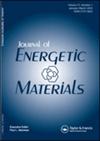用激光诱导击穿光谱法评估爆炸推进金属衬垫的终端速度
IF 1.9
3区 材料科学
Q3 CHEMISTRY, APPLIED
引用次数: 0
摘要
摘要含铝有机含能化合物是一种危害性物质,在工业上有着广泛的应用。在军用和商用烈性炸药中,格尼速度是根据金属质量与炸药质量之比确定的炸药推进金属衬里的末速。由于轮尼速度的实验测定成本较高,因此适合采用一种低成本的实验方法来可靠地估计OECAl轮尼速度。介绍了一种利用激光诱导击穿光谱(LIBS)作为高能激光脉冲来雾化和激发样品(等离子体)以评估OECAl的格尼速度的新方法。利用LIBS技术研究了5种基于1,3,5-三硝基-1,3,5-三嗪(RDX)的铝化炸药的组成,以检测其在大气中的原子和分子发射。这些成分的等离子体发射被记录在Al的原子线以及AlO和CN的分子带在某些波长具有最高强度的地方。Al (λ = 394.38和396.16 nm)、CN (λ = 388.29和422.70 nm)和AlO (λ = 467.19、484.25和464.84 nm)的峰强度与其Gurney速度相关。Al在396.16 nm处的强度与OECAl样品的格尼速度呈最佳线性关系(r2 = 0.981)。关键词:激光诱导击穿光谱;含铝有机含能化合物;等离子体发射安全;爆炸推进金属衬垫的终端速度。披露声明作者未报告潜在的利益冲突。数据和材料的可获得性在当前研究期间产生和/或分析的数据集可根据通讯作者的合理要求提供。SymbolsTableDisplay表列表本文章由计算机程序翻译,如有差异,请以英文原文为准。
Assessment of the terminal velocity of explosively-propelled metal liner using laser-induced breakdown spectroscopy
ABSTRACTOrganic energetic compounds containing aluminum (OECAl) are hazardous materials, which have extensive applications in industries. For military and commercial high explosives, Gurney velocity is the terminal velocity of explosively-propelled metal liner on the bases of the ratio of the mass of metal to the mass of explosive. Due to the high cost of experimental determination of Gurney velocity, it is suitable to have a low-cost experimental method for reliable estimation of Gurney velocity of OECAl. A novel approach is introduced to use laser-induced breakdown spectroscopy (LIBS) as a highly energetic laser pulse to atomize and excite samples (a plasma) for assessment of the Gurney velocity of OECAl. Five compositions of 1,3,5-trinitro-1,3,5-triazine (RDX)-based aluminized explosives are studied through the LIBS technique to detect their atomic and molecular emissions in the air atmosphere. Plasma emissions of these compositions are recorded where the atomic line of Al as well as molecular bands of AlO and CN have the highest intensities at some wavelengths. Intensities of Al (λ = 394.38 and 396.16 nm), CN (λ = 388.29 and 422.70 nm), and AlO (λ = 467.19, 484.25, and 464.84 nm) peaks are correlated with their Gurney velocities. The intensity of Al at 396.16 nm gives the best linear relationship (r2 = 0.981) with the Gurney velocity of OECAl samples.KEYWORDS: Laser-induced breakdown spectroscopyorganic energetic compounds containing aluminumplasma emissionsafetyterminal velocity of the explosively-propelled metal liner AcknowledgmentsWe would like to thank the research committee of Malek Ashtar University of Technology (MUT) for supporting this work.Disclosure statementNo potential conflict of interest was reported by the author(s).Availability of Data and MaterialsThe datasets generated during and/or analyzed during the current study are available from the corresponding author on reasonable request.List of SymbolsTableDisplay Table
求助全文
通过发布文献求助,成功后即可免费获取论文全文。
去求助
来源期刊

Journal of Energetic Materials
工程技术-材料科学:综合
CiteScore
5.70
自引率
4.80%
发文量
34
审稿时长
1.8 months
期刊介绍:
The Journal of Energetic Materials fills the need for an international forum of scientific and technical interchange in the disciplines of explosives, propellants, and pyrotechnics. It is a refereed publication which is published quarterly. Molecular orbital calculations, synthetic and analytical chemistry, formulation, ignition and detonation properties, thermal decomposition, hazards testing, biotechnology, and toxicological and environmental aspects of energetic materials production are appropriate subjects for articles submitted to the Journal.
 求助内容:
求助内容: 应助结果提醒方式:
应助结果提醒方式:


